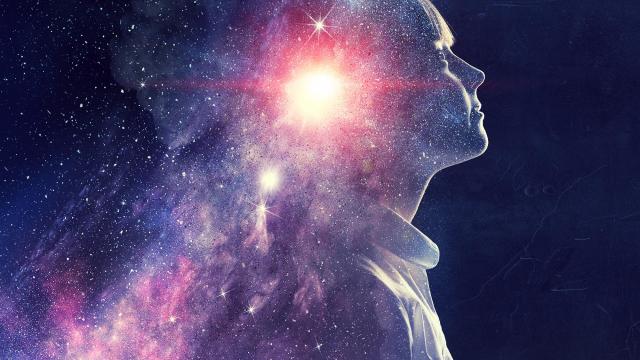Where Do Galaxies Come From?
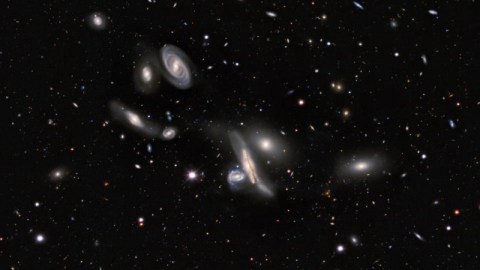
We’ve almost got the entire story. James Webb will put the last piece into place.
In all of science, there are really only two ways that something can be “known” to humanity. The most solid knowledge comes when we can observe or measure it directly, giving us incontrovertible, factual knowledge of the phenomenon in question. The second way we can know about something is theoretically: where we understand the laws, properties, and conditions that must have been in place to give rise to the phenomenon we then observe or measure later on. This latter form is an indirect form of knowledge, and we always seek experimental or observational confirmation of those ideas wherever we can.
When it comes to many questions in the Universe — the nature of dark matter, the origin of the matter-antimatter asymmetry, or the existence of the very first stars of all — we have strong evidence that certain events must have occurred, but we don’t have the direct evidence we want to understand them fully. One of those questions, simple though it may seem, is “where do galaxies come from?” There’s a tremendous amount of information we know about them, but plenty of gaps as well. Remarkably, the James Webb Space Telescope may wind up filling them all in, leading to a more complete understanding of galaxies at long last. Here’s how.
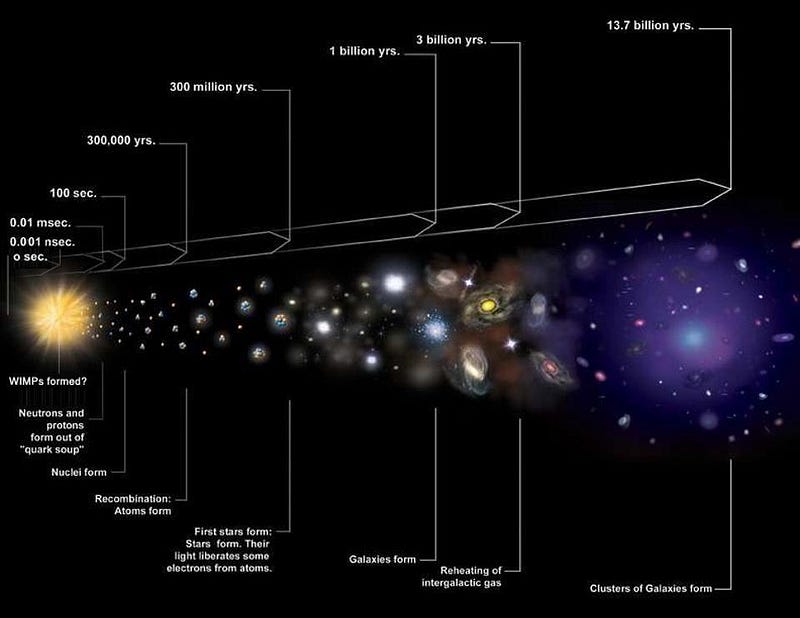
The theory. There are a few things we’ve managed to put together with some pretty strong scientific certainty about our Universe. The observable Universe, as we know it, began with the Big Bang some 13.8 billion years ago. Governed by General Relativity, it possesses a specific relationship between the fabric of spacetime itself and the presence and distribution of all forms of matter and energy. It was hot, dense, and rapidly expanding, and was almost — but not perfectly — uniform. On all scales, from tiny, microscopic ones all the way up to the largest cosmic ones, there were tiny imperfections: at about 1-part-in-30,000 level.
Over time, the imperfections that correspond to overdense regions must have grown, preferentially attracting more and more matter to them, while the average and underdense regions give up their matter to the denser locations. After enough time has passed, the overdense regions become massive and dense enough that they can undergo gravitational collapse, leading to star-formation, star clusters, and eventually, after enough growth and/or mergers have taken place, the first galaxies. As time goes on, these galaxies grow and merge further, evolving into the modern-day ones we see at present.
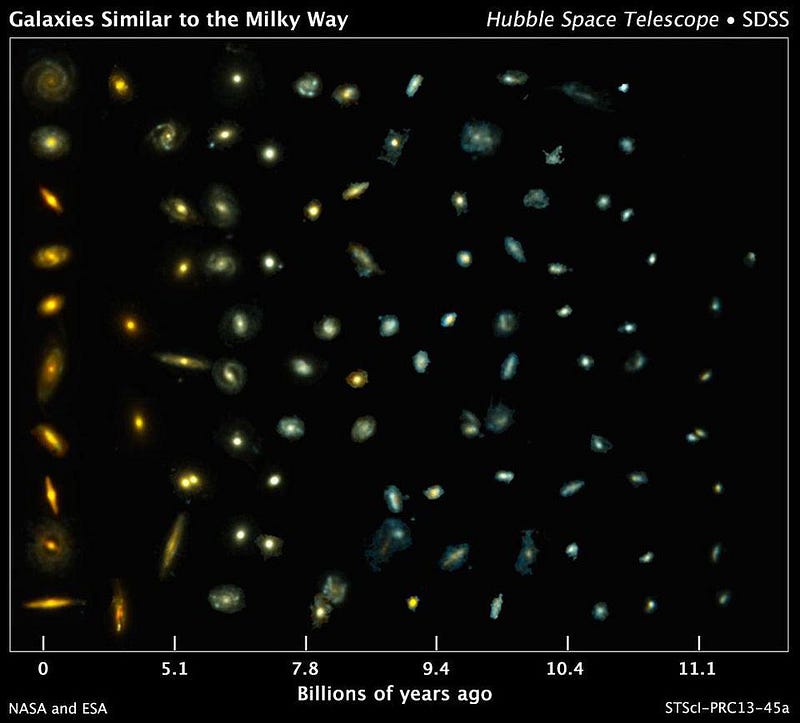
The observations. There’s a lot that we can see and measure to support this picture, but there are a lot of gaps as well: places where the direct observations that would fill in the unknown details are missing. At late times, we see galaxies as they are today: large, massive, evolved, and full of heavy elements, which indicate how much processing has taken place due to the prior generations of stars. As we look farther and farther away — which corresponds to looking back to earlier times — we can see how similar galaxies were different in the past.
As you might expect, they were smaller, less massive, less evolved, and contained fewer heavy elements the farther back we look. Over more than 10 billion years of cosmic history, we see this trend continue. The earliest galaxies are made of younger stars, dominated by the bright, blue, short-lived massive stars that are likely to go supernova. Over some ~90% of the Universe’s history, we can see how galaxies grow and evolve, and it’s a spectacular case where theory and observations match.
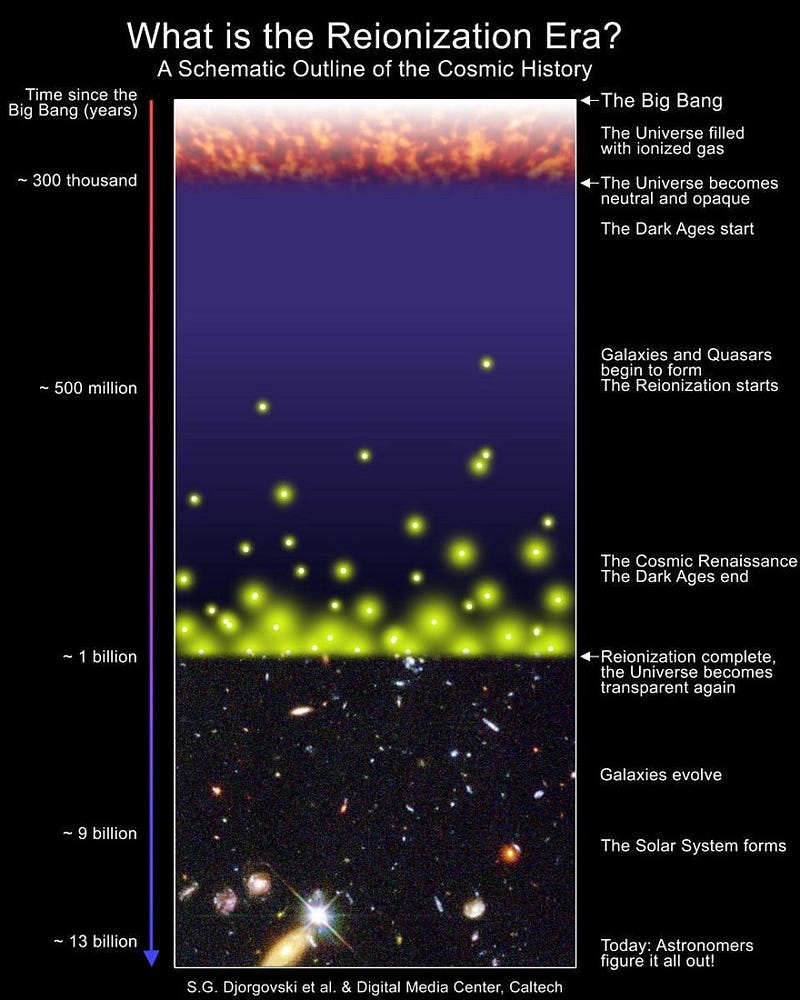
At the limit of the Hubble Space Telescope’s capabilities, however, there are two obstacles that get in the way. Beyond a certain point, our view of the galaxies is tremendously obscured, for the following two reasons.
- The Hubble Space Telescope is optimized for viewing the Universe in certain wavelengths of light: ultraviolet, visible light, and the near-infrared part of the spectrum. Wavelengths that are too short or too long cannot be seen by this observatory.
- At early times, less than ~550 million years after the start of the hot Big Bang, the Universe is no longer transparent to optical light, as there are neutral, not-yet-ionized atoms permeating the intergalactic medium that block too much of that light to observe.
When light from galaxies that existed at the earliest of times, before that ~550 million year mark, is emitted, these two difficulties largely prevent us from viewing the Universe before that epoch. However, there’s one exceptional counterexample: the most distant galaxy ever discovered, GN-z11.
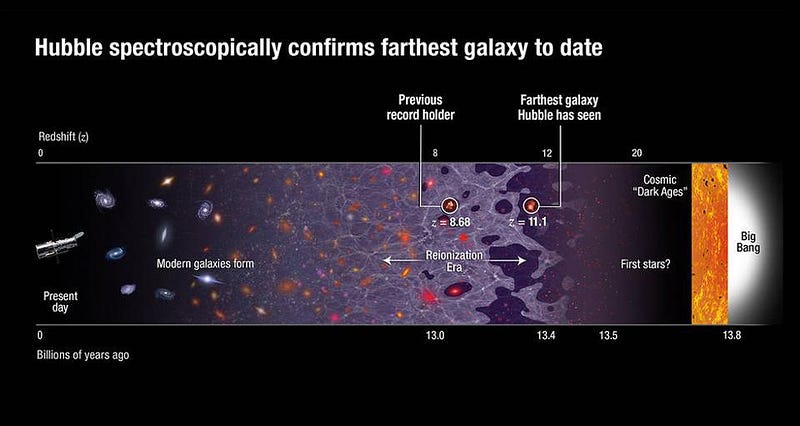
Overcoming the observational limits. How did Hubble manage to image this galaxy? Two things serendipitously lined up to help us overcome these cosmic obstacles.
The first is — going back to our theories once again, albeit theories that are informed by supporting observations — that the distribution of neutral atoms throughout the Universe isn’t uniform. Wherever you have large amounts of stars that form early on, you get lots of ultraviolet radiation that smashes into the neutral atoms that surround them. This radiation is energetic enough to ionize them, enabling that portion of the Universe to be transparent.
Along some lines-of-sight, this ionization will occur at earlier times than others, while it will take longer in other directions. The galaxy GN-z11 happened to be located along a particular line-of-sight where this ionization occurred more swiftly than average, which led to a larger fraction of the light getting through than normal. As a result, we can see GN-z11 as it was just 407 million years after the Big Bang: when the Universe was only 3% of its current age.
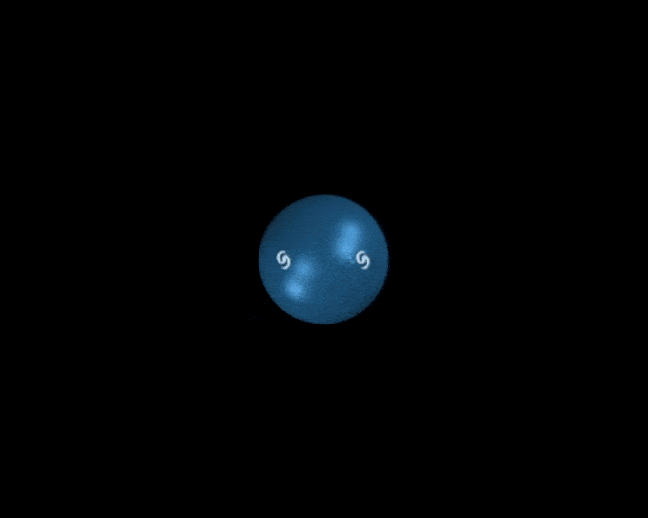
There’s also the problem of the expanding Universe. When the light from these young, hot, early stars is first emitted, it’s mostly in the ultraviolet portion of the spectrum. However, as that light travels through the Universe, it experiences a redshift: getting stretched to longer wavelengths. You can imagine that light is defined by its wavelength, which is a particular distance that corresponds to light of this particular energy.
As the Universe expands, distances expand too, and that wavelength gets stretched to larger distances. Larger distances for a wavelength mean lower energies and redder light. At the distance of GN-z11, light that’s emitted in the ultraviolet gets stretched so severely that it’s shifted all the way into the infrared: at double the wavelength of where the visible light portion of the spectrum ends. It’s only because of the latest instrumentation on Hubble, which pushes the limits of its infrared capabilities out beyond those limiting wavelengths, that we’re able to see the light emitted from this galaxy at all.
And even with all of this, we wouldn’t have been able to see it even with Hubble if there weren’t an extra factor at play: gravitational lensing.
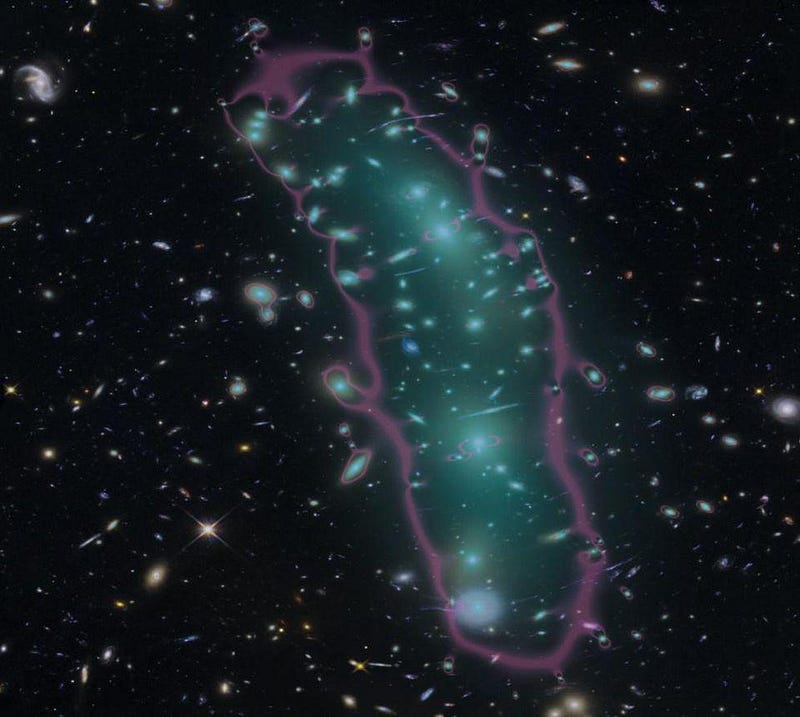
An assist from gravitation. When light travels through the Universe, it has to — for better and for worse — pass through the entirety of the space between the emitting source and the observer’s destination. While astronomy is mostly concerned with the intervening matter along the journey, which can absorb or disperse light or otherwise alter its properties, sometimes there’s a very massive object along or near the line-of-sight connecting the emitter and the observer. When that occurs, the extreme curvature induced in the intervening spacetime can distort and magnify the background light through the process of gravitational lensing.
Objects that would otherwise be too faint to be seen can be magnified many times over, by factors of dozens or even 100+, depending on the geometric configuration. The faintest, deepest data from the distant Universe, largely collected from the Hubble and Spitzer space telescopes, reveals the most distant lensed galaxies of all. Whenever we look near a large foreground galaxy cluster, the effects of gravitational lensing can help us see farther and fainter than would ever be possible otherwise.
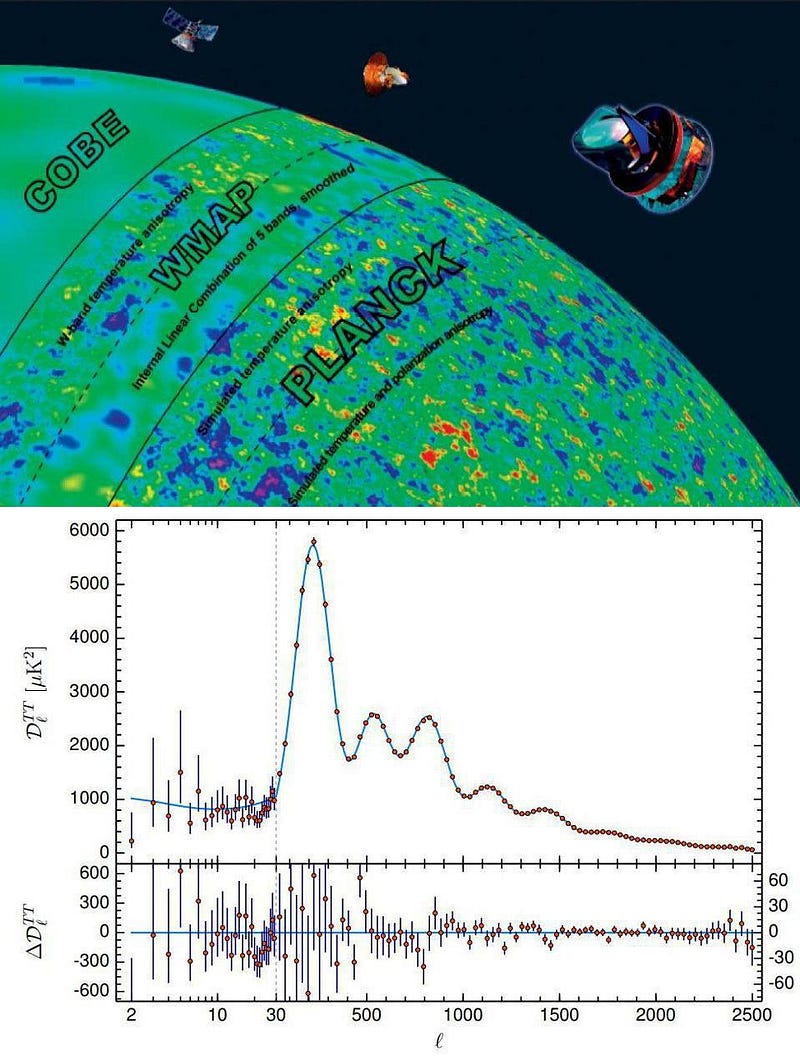
Observational hints from the Big Bang itself. Imagine the Universe as it was long ago: before any galaxies, stars, or even atoms had formed. In these very early stages, we still have the overdense (and underdense) regions, but they don’t grow (or shrink) the way you probably expect. Before you have neutral atoms, photons can interact easily with the free, unbound electrons, allowing for the unfettered exchange of energy and momentum.
Whenever an overdense region attempts to grow through gravitational collapse, the radiation pressure goes up, causing additional photons stream out from it. This eventually leads to a “rebound” which causes the density on that particular scale to drop. These “rebounds” happen many times for smaller scales, fewer times on slightly larger scales, and there will be one particular scale — when the Universe finally becomes electrically neutral some 380,000 years after the Big Bang — where things are rebounding for the first time. These series of “rebounds” then show up in the spectrum of fluctuations in the cosmic microwave background, which serve as the seeds that will eventually grow into the Universe’s large-scale structure.
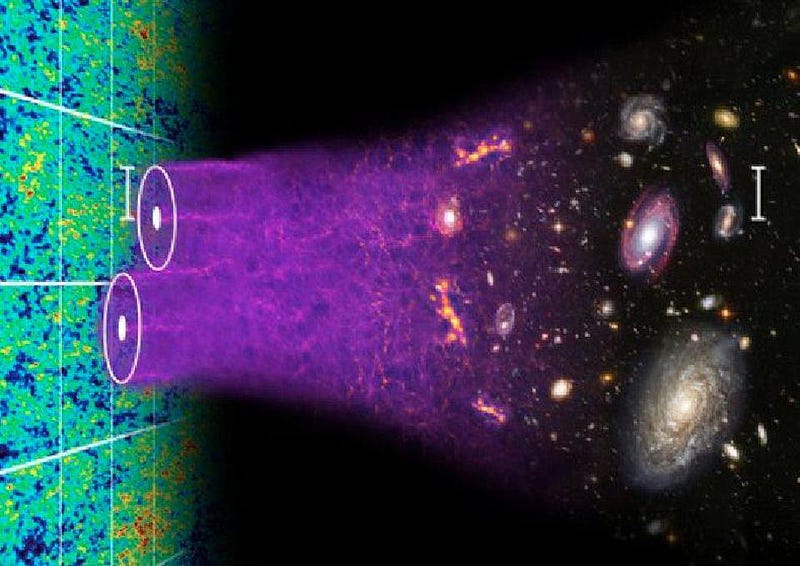
The gaps in our observations. This leaves us with an enormous gap: from 380,000 years after the Big Bang, when the light from the cosmic microwave background was emitted, until about ~400 million years after the Big Bang: when we see the earliest luminous objects ever detected. At some point during this time, when matter is still largely neutral (and hasn’t been reionized by starlight) and the Universe is opaque to the small amounts of starlight that do exist, the following things must have happened.
- Matter must have gravitated, forming large-mass clouds of gas on small scales.
- Those clouds must have gravitationally contracted, leading to the formation of the first, pristine stars.
- Those stars must have lived-and-died, enriching the Universe with heavy elements.
- That subsequent material gets taken up in future generations of star formation, leading to second-and-later generations of stars.
- And those later generations formed star clusters, which grow by accreting matter and merging together, forming the earliest proto-galaxies.
- Those early galaxies then grow and merge, leading to the earliest types of galaxies we’ve revealed thus far.
Right now, only the results of that final step — the earliest galaxies revealed so far — are available to us today, in 2021. But by this time next year, the hope is that all of this will have changed.
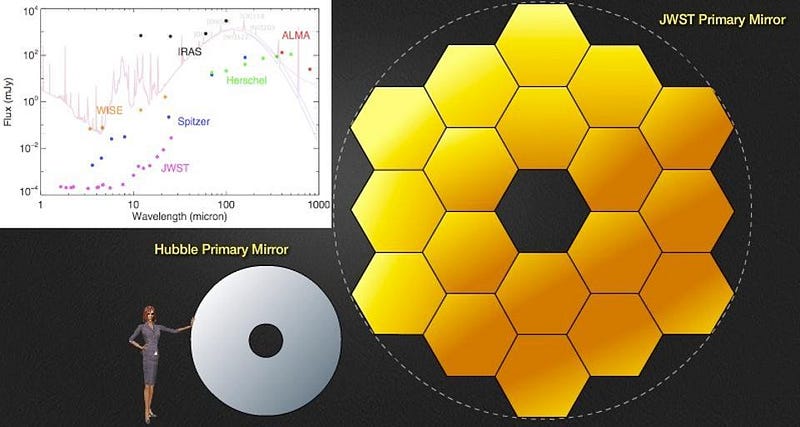
What’s coming with James Webb? In just 6 months, NASA’s James Webb Space Telescope is slated to launch. It will have improved instrumentation as well as fundamental capabilities that Hubble lacks, including:
- the ability to see far into the infrared, up to wavelengths of ~30 microns, as opposed to Hubble’s ~2 micron limit,
- significantly improved light-gathering power, with a diameter of 6.5 vs 2.4 meters, collecting seven times the data as Hubble over the same timespan,
- and will operate at extremely low temperatures, improving the signal-to-noise ratio and allowing Webb to measure at wavelengths where all Hubble “sees” is thermal radiation from inside the telescope.
In just the first year of its operation, Webb should find significant numbers of galaxies that are fainter, more distant, and less evolved than anything Hubble has ever seen. It may even, if we get lucky with our observations, give us our first glimpses of the very first populations of stars — the stars made exclusively of pristine, direct-from-the-Big-Bang material — that must exist, but have not yet been revealed. We may even witness stellar cataclysms like supernovae from these pristine stars, if we’re lucky enough to find them.
The biggest gap in our understanding is how the earliest stars and galaxies formed, and that’s precisely the scientific question that James Webb is optimized to answer.
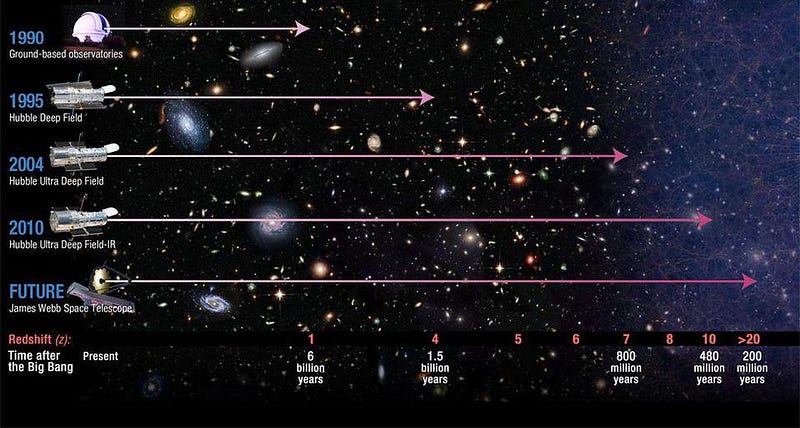
If Hubble showed us what the Universe looks like, then James Webb will teach us how the Universe grew up into what it is today. We have direct information, going back to the very early stages of the Big Bang, that illuminates what the seeds of our modern galaxies look like, and we have direct information some 400 million years later, showing us what those early-type galaxies have grown into. From those early times to the present day, we can fill in a remarkable number of those subsequent details, but we have no observational clues as to how those first galaxies truly arose.
The James Webb Space Telescope, just six months from now, will launch towards its ultimate destination. By 2022, we should begin taking observations of the deepest corners of the Universe: those far reaches that have been invisible to every other observatory thus far. We have a theoretical picture for how galaxies ought to arise, and at last, the observational data is about to catch up. Whatever it is that we find will be a thrilling victory for the enterprise of science, with chances to discover something more revealing than anyone has yet anticipated.
Starts With A Bang is written by Ethan Siegel, Ph.D., author of Beyond The Galaxy, and Treknology: The Science of Star Trek from Tricorders to Warp Drive.





